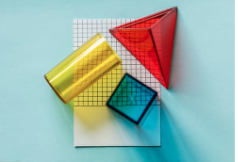
Geometry - Plane Figures/Polygons

Overview
Students will learn about plane shapes and characteristics of polygons by viewing and singing the PolygonSong and the Greedy Triangle by Marilyn Burns. They will create and identify polygons by comparing and contrasting sides of plane shapes.
The students may use the PicCollage app (iPads) to create collage pages of five different types of polygons. (Google Play Download)
This activity will take one-two class periods to complete.
Learning Objectives
Students will:
- Be able to identify, describe, and analyze 2-D shapes.
- Be able to classify shapes based on their attributes (comprehension).
- Be able to manipulate/build shapes (application).
- Be able to compare/contrast shapes (analysis).
- Be able to design a picture collage using the iPad app (synthesis).
- Be able to conclude which characteristics represent 2-D shapes and how the shapes can be created (evaluation)
Vocabulary
Vocabulary Words:
- Plane Shapes: A plane shape is a closed, two-dimensional figure.
- Solid Figures: A solid figure is a three-dimensional shape.
- Polygons: A polygon is any two-dimensional shape formed with straight lines.
Pre-planning
To prepare for this lesson:
-
This activity will take one to two math periods to complete
-
The teacher will create a collage with polygons and their names using the iPad PicCollage app. You can also download PicCollage for Android devices on the Google Play Store.
-
Look up and bookmark the video PolygonSong.
-
Look up and bookmark the video The Greedy Triangle by Marilyn Burns.
-
Download the Name the Shape worksheet from education.com.
-
Download the app PicCollage on the student devices.
-
Gather the following for the students to use: toothpicks, glue, plane figure cutouts and crayons.
Note: If students do not have iPads, the teacher can use his/her iPad to take pictures. The teacher can create the collage and share it with the students.
Accommodations
See Accommodations Page and Charts on the 21things4students.net site in the Teacher Resources.
Steps
Directions for this activity:
Introduction
- Assess prior knowledge by viewing pictures from PicCollage and identifying shapes seen, the number of sides on the shapes, and corners.
Guided Instruction
- Ask students, “Who can tell me which shape does not belong with the other shapes that you see in the picture?”
- Differentiate between plane and solid shapes.
- Say, “Think about the sides of that shape- How many sides does it have?”
- Go through several more pictures. Have students use dot paper to draw various shapes and name them.
- Say, “Now we are going to look at shapes with more than four sides.”
- Discuss how polygons are closed plane figures (not solids) with straight sides made up of line segments. Polygons can be measured by length and width.
- View video: Polygon Song - The song prompts students to draw the shapes in the air while counting out the sides.
- Have students go on to Identify Plane Shapes activity. Explain directions and student choice activities.
- If the students have devices, conclude the lesson with a student created PicCollage of five different types of polygons
Assessment Options
Different options for assessing the students:
- Observations
- Check for understanding
- Observation
- Create a polygon collage using PicCollage App
- Quick Quiz (teacher created)
- Early Finisher Choice Activity
-
Early Finishers
- Picture Shapes Activity- Draw a picture using shapes and then count and record shapes used.
- Create Activity- Create polygons with toothpicks to show shape’s sides and angles
- Video or read: The Greedy Triangle by Marilyn Burns
MITECS Competencies & ISTE STANDARDS
MITECS: Michigan adopted the "ISTE Standards for Students" called MITECS (Michigan Integrated Technology Competencies for Students) in 2018.
Empowered Learner
1a. Students articulate and set personal learning goals, develop strategies leveraging technology to achieve them and reflect on the learning process itself to improve learning outcomes.
1c. Students use technology to seek feedback that informs and improves their practice and to demonstrate their learning in a variety of ways.
1d. Students understand the fundamental concepts of technology operations, demonstrate the ability to choose, use and troubleshoot current technologies and are able to transfer their knowledge to explore emerging technologies.
Innovative Designer
4a. Students know and use a deliberate design process for generating ideas, testing theories, creating innovative artifacts or solving authentic problems.
Devices and Resources
Device: iPad
App, Extension, or Add-on:
Apple App Store
PicCollage Google Play
Websites:
Name the Shape Sheet from education.com
PolygonSong
Read Aloud Video: The Greedy Triangle by Marilyn Burns
CONTENT AREA RESOURCES
ELA
- RL.2.2. Recount stories, including fables and folktales from diverse cultures, and determine their central message, lesson, or moral.
- RL.2.3. Describe how characters in a story respond to major events and challenges.
Math
2.G.1 – Identify, describe, and compare 2-D shapes
Science
- 2-PS1-1. Plan and conduct an investigation to describe and classify different kinds of materials by their observable properties
- ETS1-2 Develop a simple sketch, drawing, or physical model to illustrate how the shape of an object helps it function as needed to solve a given problem.
CREDITS
This task card was created by Amy Wert, Archdiocese of Detroit, August 2019. Updated November 2021.


